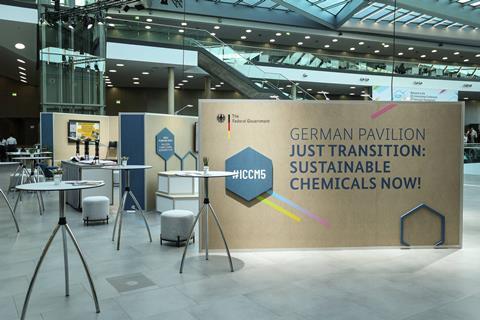Chemical companies entered cost-cutting mode in a year dominated by overcapacity and slow demand
The chemical sector racked up losses this year as it came up against a cluster of challenges including high operating costs, low demand and an overabundance of production capacity.
The year was particularly brutal in Europe where inflation and energy prices crimped demand for chemicals. In response to evaporating earnings, companies settled firmly into cost-cutting mode. Announcements of plant closures rippled through the year, with casualties including Trinseo’s ethylbenzene and styrene plant in the Netherlands, Celanese’s nylon 6,6 plant in Germany, and Kem One’s chlor-alkali plants in France.

Others announced brutal job cuts. Early in the year, Dow revealed plans to save $1 billion (£826 million) in 2023 by laying off about 2000 people, among other measures; 3M said it would cut 2500 jobs globally. Lanxess plans a one-time saving of €700 million (£600 million) in 2023 and annual savings of €150 million starting in 2025. The cuts will eliminate 870 jobs, including 460 in Germany, and the company will sell its urethane chemical division and use the money to help pay down debt.
And BASF, which recorded a 28% drop in sales, now aims to reduce costs by more than €600 million per year by the end of 2024 and more than €700 million by the end of 2026, from the cost reduction plan it began in late 2022. ‘If chemical production does not further stabilise, there are risks from a further decline in volumes and a sharper-than-expected price reduction,’ said chief executive Martin Brudermüller in an October earnings call. ‘Looking ahead, we do not expect an easy start to 2024.’
Although US companies – including Eastman and Huntsman – also reported lower earnings, the sector generally fared better financially. Asian firms, on the other hand, experienced losses that rivalled Europe in their bleakness. Sumitomo Chemical is predicting an operating loss of ¥97 billion (£530 million) for the fiscal year, while Mitsubishi Chemical suspended production at its methyl methacrylate plant in Billingham, UK, and set a cost-reduction target of ¥135 billion for the period 2021–2025.
Both firms suffered from declining demand due to the slow recovery of the Chinese economy. Soft demand from China – formerly an engine for global demand growth – coupled with new giant plants ramping up operations within the country, has led to the greatest overabundance of production capacity in decades.
Credit ratings agency Moody’s expects oversupply to strain profit margins for the next year and to force more petrochemical facilities in Europe to shut down. ‘The primary impact on Europe’s chemical sector comes from China’s significant capacity additions in commodity chemicals such as [purified terephthalic acid], styrene, [methyl methacrylate], polycarbonate, nylon and silicones,’ Moody’s analysts told Chemistry World.
Shale consolidation
It was a slow year for mergers and acquisitions in the chemicals industry generally. However, rising oil prices provided a profit boost for oil and gas companies, and triggered some significant acquisitions. The largest of these were the $59 billion paid by ExxonMobil for US shale oil specialist Pioneer Natural Resources, followed swiftly by Chevron agreeing a $60 billion deal to buy Hess, for its holdings in Guyana and the US Bakken shale field.
Service provider KPMG expects these deals to encourage similar acquisitions, where mid-size producers are displaced by the largest companies in the oil and gas industry.
For the chemical industry, 2024 might see a rebound in merger and acquisition activity as corporates sell underperforming businesses in the US and Europe, said Gillian Morris, head of advisory for chemicals at KPMG US. ‘Will there be more consolidation? I think there will be new owners of traditional chemical businesses – sovereign wealth funds or private equity. I do not see corporate carve outs being traded to other corporates in the same regions,’ Morris told Chemistry World.
Slow but steady in sustainability
Despite their struggles, many companies pressed on with projects to reduce carbon emissions, acknowledging the economic and political imperative.

Among other projects, Arkema is making a €130 million investment in implementing a new purification technology at its acrylic monomer plant in Carling, France, that it says will reduce the site’s carbon dioxide emissions by 20%.
BASF and partners fitted the last transformers at a demonstration electric steam cracker furnace in Germany. BASF claims that the approach can reduce CO2 emissions by 90% compared with a gas-fired furnace, when run on renewable power.
Yet, the market for sustainability investments was looking less vibrant in 2023 than in the years before, as firms started to take a sober look at the costs and potential returns.
A November report by consultancy Accenture found that only 12–16% of chemical and industrial companies, and only 8% of energy and natural resources firms, are on track to reach net zero operational emissions by 2050. Of the surveyed companies, 38% blamed the current economic environment for curtailing their decarbonisation investments.
Regulatory revisions
2023 also saw long-awaited progress in the regulatory world, with eight years of negotiations on a new global approach to chemicals management coming to fruition in a 30 September agreement at the fifth International Conference on Chemicals Management (ICCM5) in Bonn, Germany.

The agreement covers the adoption of legal frameworks for chemicals in all countries. Alongside the framework text, ministers and organisational leaders signed the high-level ‘Bonn Declaration’. This aims to emphasise the ‘determination and commitment to take urgent and ambitious action’ on global challenges related to chemicals.
In the EU, however, the regulatory agenda stagnated and politicians and campaign groups watched with fury as an overhaul of the Reach (registration, evaluation, authorisation and restriction of chemicals) legislation was delayed for a third time. The proposal was initially set to be published by the end of 2022, but has now been left out of the European Commission’s 2024 work programme.
The latest delay places the file in the hands of the next commission, to be elected in June 2024. It came after the German trade body VCI and other industry representatives lobbied to pause work on the chemicals strategy for sustainability (CSS) in light of the challenging times.
But Michael Warhurst, executive director at the campaign group Chem Trust, said the delay ‘may not sound like much, but it would mean that the current European parliament cannot discuss the measures, and the implementation of the new laws would be delayed by at least one or two years. The next commission could even try to modify or withdraw the proposal.’
The UK experienced similar delays. The government’s own chemicals strategy is now expected in 2024, despite first being promised in 2018 and having deadline after deadline pushed back since 2022.
In steps forward, however, the government set the policy direction for its long-awaited alternative transitional registration model for GB Reach. It also set mandatory classifications for chemicals under post-Brexit legislation for the first time in October.
Britain further distanced itself from the EU in reinstating a strict ban on animal testing of chemicals used solely in cosmetics. The announcement came in stark contrast to the November conclusion of an EU general court case that will force the company Symrise to carry out vertebrate animal tests on two cosmetic ingredients under EU Reach, to determine any risks posed to manufacturing workers or the environment.
PFAS under pressure
Per- and polyfluoroalkyl substances (PFAS) remained top of the news and regulatory agenda in 2023. Legal pressure on PFAS producers continues, with DuPont spin-off Chemours challenged over its environmental emissions in both the US and the Netherlands. The Dutch district court in Rotterdam ruled that Chemours can be held accountable for environmental damage in the Netherlands caused by releases of PFAS between 1984 and at least 1998. Meanwhile, embattled manufacturer 3M committed in January to ending production of all its PFAS products by the end of 2025.
In March, the US Environmental Protection Agency (EPA) proposed new drinking water limits for six common PFAS chemicals, including specific limits of 4ng/l for perfluorooctanoic acid and perfluorooctanesulfonic acid. Meanwhile in the UK, the Royal Society of Chemistry (RSC) called on the government to reduce the current cap on individual PFAS chemicals in drinking water from 100ng/l to 10ng/l, warning that levels above this pose a significant risk to public health.
In September, the US EPA also finalised a major reporting rule that will require manufacturers and importers of PFAS and PFAS-containing articles to provide information on, among others, the uses, byproducts, potential toxicity and exposures for PFAS in their products or processes.
‘The data we’ll receive from this rule will be a game-changer in advancing our ability to understand and effectively protect people from PFAS,’ Michal Freedhoff, assistant administrator for the EPA’s office of chemical safety and pollution prevention, said in a statement. Chemical industry trade body the American Chemistry Council, on the other hand, called the rule ‘another step in the concerning trend of regulatory overreach’.
In the EU, a plan proposed by the governments of the Netherlands, Germany, Denmark, Norway and Sweden aims to regulate PFAS collectively and restrict more than 10,000 of them under Reach. The European Chemicals Agency collected a record 5600 responses from stakeholders in a public consultation on the proposal.
Many of these are from fluoropolymer producers and users calling for these substances to be exempted from the ban. Others are calling for the entire proposal to be thrown out. The final proposal is expected to be presented to the European commission in 2025.
Skills shortage
Despite the job cuts hitting headlines, access to certain skilled labour posed another rising problem for the sector this year. A report by the Campaign for Science and Engineering found that the skills shortage is costing the economy £1.5 billion a year and urged the government to step up support for training and education in technical fields and to redesign the visa system to attract more international talent.
‘While there is not a crisis in general, certain roles such as [heavy goods vehicle] drivers have been in decline for many years,’ Tim Doggett, chief executive of the Chemical Business Association, told Chemistry World.
However, Doggett said the sector is facing a potentially much bigger problem, with many skilled and experienced employees retiring in coming years and a shortage of talent among the generation set to replace them.
‘Creativity is becoming increasingly important; it gives a competitive advantage, especially during the age of AI and if we only focus on [science, technology, engineering and maths] we miss out on great people,’ Doggett said.
‘As the world transitions towards a net-zero carbon economy, it is crucial to equip the industry with the right talent and skills to drive innovation, address complex challenges, and embrace sustainable practices.’
References
Additional information












No comments yet